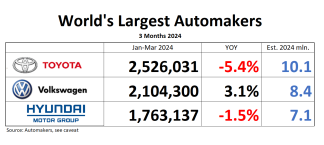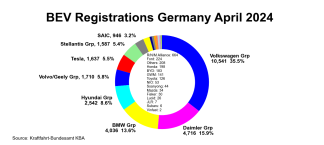- Daimler Throws Shade at Tesla E-Trucks Plan as Rivalry Heats Up – Bloomberg: If that happened, Daimler would have miscalculated to an unimaginable degree, head of trucks Martin Daum suggested to reporters at an event Wednesday in Stuttgart. He announced plans to start rolling out Mercedes-Benz electric trucks for trials this…
- Ferrari 488 Pista revealed with 711bhp V8 derived from racing – Autocar: The model uses the most powerful V8 in Ferrari”s history The best supercar in the world just got lighter, punchier and even more focused; it’s the most powerful V8 Ferrari yet produced
- Ford aims to set up German bank this year to offset Brexit risk – Automotive News: Ford Credit Europe sought a German banking license, to run alongside its existing British one, last year because the future of passporting, which allows financial firms to serve the whole EU from a single base, is uncertain after Brexit. “We anticipate…
Archives for February 2018
Wednesday Morning Auto News, Feb 21, 2018
Will China hold our electric future at ransom? Not if Toyota can help it
If the supply of electric vehicles is to grow as predicted, the demand for strategic materials will increase along with it. The various oil crises of the past, and the wars that came with it, illustrate where such a dependency can lead. As far as electric vehicles are concerned, two choke points have been identified: The supply of cobalt needed to make batteries, and the supply of rare earth minerals needed to make the magnets in electric motors.
There are two ways to address the problem. We can hope it will take care of itself. Or we can do something about it. Toyota is in the second camp, and it aims to reduce the dangerous dependency on neodymium. Expensive neodymium already is the main cost driver in the production of magnets, we heard today at a meeting at Toyota’s Tokyo HQ. If electric vehicles will gain popularity as expected, shortages of neodymium could occur as early as 2025, Akira Kato, general project manager at Toyota’s R&D company, told us today. [ There is more … ]
Tuesday Morning Auto News, Feb 20, 2018
- Toyota readies cheaper EV motors by halving rare-earth metal use – Automotive News: Toyota Motor is readying electric motors that use much as 50 percent less in rare-earth metals amid concern of a supply crunch as automakers race to expand their EV lineups. Toyota has developed a magnet for the motors that as much as halves the use of…
- BMW M4 Convertible Edition 30 Jahre celebrates 30 years of M convertibles – Autocar: BMW has been making drop-top M-cars for 30 years now Only 30 of the limited-run special edition will come to the UK, priced from £76,675
- Why Aston Martin is mulling risky move into F1 – Automotive News: After returning Aston Martin to profit, Andy Palmer envisions the British supercar maker entering Formula One as an engine supplier by 2021. F1 is trying to lure well-known brands such as Aston Martin and Porsche to the race series by promising to make…
Monday Morning Auto News, Feb 19, 2018
- Mercedes-Benz accused of equipping vehicles with emissions manipulation software – Autocar: An unspecified number of diesel models could be affected The software programs allegedly used by Mercedes-Benz could be similar to those developed by Volkswagen
- Daimler shares fall after report about software device in Mercedes cars – Reuters: Analysts said Daimler’s regulatory problems may not be of the same magnitude as those seen by Volkswagen and Fiat Chrysler (FCHA.MI). Unlike Fiat Chrysler, the U.S. Environmental Protection Agency (EPA) has not chosen to issue a notice of violation…
- National Grid plans 350kW EV charge point network – Autocar: Chargers with up to 350kW charging capacity could be installed in 50 locations on UK motorways, providing easy access to 96% of UK citizens
Friday Morning Auto News, Feb 16, 2018
- Volkswagen’s Audi unit head Stadler to leave in April – Bild – Reuters: The chief executive of Volkswagen’s luxury unit Audi, Rupert Stadler, will be replaced in April because of his unsuccessful handling of the diesel emissions scandal, … VW unit Skoda’s head Winfried Vahland is seen as the top candidate to succeed him,…
- Audi denies CEO Stadler will be replaced by former Skoda boss – Automotive News: Audi Chairman Matthias Mueller said that reports about an imminent ouster of CEO Rupert Stadler are false. Germany’s daily newspaper Bild reported that Stadler will be replaced in April because of his unsuccessful handling of the diesel emissions…
- Record Renault earnings strengthen Ghosn’s hand – Reuters: Renault shares were up 3 percent at 88.59 euros at 0905 GMT. Operating profit at the core automotive division, excluding the recently consolidated AvtoVAZ business in Russia, rose 15.2 percent to 363 million euros. The company raised its proposed…
- Carlos Ghosn: ‘We’re probably the only carmaker who’s starting to make money selling electric cars’ – CNBC: The auto alliance between Renault, Nissan and Mitsubishi is probably the most advanced and profitable carmaker when it comes to producing electric cars, the company’s CEO told CNBC Friday. The alliance, which started work on electrification back in…
Thursday Morning Auto News, Feb 15, 2018
- 2018 Kia Ceed revealed: revamped hatch takes aim at Golf – Autocar: This is the new Kia Ceed Kia”s rival to the Golf and Focus is due at Geneva motor show alongside an estate version; a shooting brake is expected later this year
- 2019 Toyota Supra leaked: 1496kg, 335bhp, 0-62mph in 3.8sec – Autocar: This is our best look yet at the 2019 Toyota Supra Styling and some statistics of upcoming sports car appear to have been leaked by Japanese media; Toyota won’t confirm if they’re legitimate
- A star is born: Volvo’s Polestar1 pioneers electric-luxury brand; US sales begin in 2019 – Freep: Volvo’s new Polestar brand for high-performance electric vehicles is racing toward the start of public sales, with its first car – a 600-horsepower plug-in hybrid – debuting shortly and two more all-electric vehicles in the works. The brand expects to…
Wednesday Morning Auto News, Feb 14, 2018
- 370bhp Ford Focus RS Heritage Edition lands as hardcore swansong – Autocar: The run-out version of current Ford Focus RS features a Quaife locking differential at the front and Mountune power upgrade
- GM, Ford, VW, Toyota among automakers providing up to $130 million for Takata’s US settlement – Automotive News: Honda has faced the greatest number of airbag-related claims of the automakers, and 20 of the deaths have occurred in Honda vehicles, most of which were in the United States. In return for funding the trust, Honda will be shielded from further…
- Edmunds offers top picks for stick shifts – Washington Post: For a more luxurious experience, there’s the 2018 Audi A4. A manual transmission is available in all three of the A4’s trim levels:, Premium, Premium Plus and Prestige. And it is paired to a turbocharged 2.0-liter four-cylinder engine and all-wheel…
- Dyson plans three-car EV range – Autocar: Second and third cars will follow a low-volume first model, as the brand looks to penetrate the car industry from 2019
Searching For “Production Hell” At Ford’s Kentucky Truck Plant

As Tesla has blown through one Model 3 production volume deadline after another, the automotive upstart’s “production hell” has become a topic of intense scrutiny and debate. Among fans of the company, the overwhelming majority of whom have little to no exposure to automotive manufacturing, the belief that Tesla must be innovating bold new manufacturing techniques that will leave the “legacy” automakers in the dust has become an article of faith. But if you spend some time at one of the established auto manufacturing plants that currently pumps out products and profits that Tesla can only dream of, it quickly becomes clear that the Silicon Valley startup culture that fuels Tesla’s innovative design and blistering performance is more liability than asset when it comes to the difficult task of actually making cars.
A recent visit to Ford’s Kentucky Truck Plant (KTP) put the contrast between Tesla’s approach to automaking and that of the established automakers into sharp relief. Even before I set foot in the massive facility, it became clear how much more confident Ford is in its manufacturing operation than Tesla. Whereas Tesla typically only opens its Fremont factory to Tesla owners who are required to sign nondisclosure agreements, Ford’s tour took select news media through nearly every portion of the plant (including the paint shop, which almost every factory limits access too), encouraged us to speak to any worker we liked, and asked only that we keep news of a new $25 million investment embargoed for a few days. If Ford were experiencing the “production hell” that has characterized every new Tesla product ramp we would have had no problem recognizing it.
What we saw instead was the intricate ballet of modern automotive manufacturing, a complex yet precise operation involving thousands of workers, robots and suppliers. We saw the fascinating mix of humility and pride among the workers who make up the foundation of the production system, the tight choreography of a fully automated body shop that turns sheets of aluminum into vehicle bodies, the firehose of data that keeps the entire system working together and the latest 3D printing technology that Ford has brought in to continuously improve –rather than replace– the humans and robots that move tirelessly to the beat of an unseen drummer. And at the end of the line, we saw that beat made manifest in a new Ford SuperDuty pickup, Expedition, or Lincoln Navigator rolling off the line at a steady rate of more than one per minute.
In short, nothing about KTP suggested anything that might be described as “production hell,” even as it produced more vehicles every day than Tesla makes Model 3 in a week. And though it may not have looked like an illustration from a speculative SciFi novel about the factories of the deep future, KTP also gave no indication of being a laggard in production or quality that might be disrupted by Tesla or anyone else.











